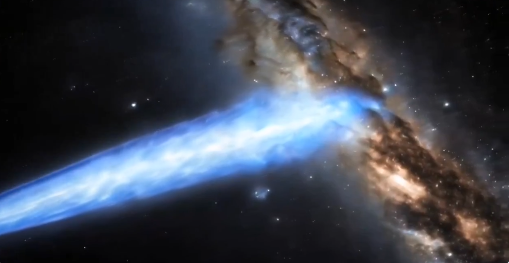Astronomers, peering into the endless night of the cosmos, stumbled upon something vast—something that rattles the very scale we use to measure the universe. A pair of immense jets, flung from the heart of a supermassive black hole some 7.5 billion light-years away. These cosmic beams stretch across 23 million light-years, a span that dwarfs anything seen before. It’s as if the universe, in its quiet hum, has rewritten its own epic—a tale far larger than we had imagined.
A massive discovery 🔭
Astronomers have spotted the largest plasma jets ever seen, streaming from a supermassive black hole 7.5 billion light-years away in a galaxy named Porphyrion.
These jets span 23 million light-years! pic.twitter.com/8Pd1Od1xg9
— Royal Institution (@Ri_Science) September 19, 2024
Black holes—we often picture them as voracious monsters, pulling everything into their grasp, swallowing light and matter alike. But they don’t just consume. In moments before the final fall, they hurl out material, fierce and glowing, in radiant jets that race through space. These streams, packed with particles and energy, shine in the view of telescopes back here on Earth. Martijn Oei, leading the discovery, speaks almost in awe of what they’ve found. “These aren’t just jets,” he says, “they stretch 140 times farther than the Milky Way.”
The astronomers named this behemoth *Porphyrion*, after the ancient Greek giant, a fitting name for something so colossal that it rivals the power of trillions of suns. And now, this discovery forces them to pause, to reconsider the very fabric of the universe—how can jets like this come to be, and why do they stretch so far into the void?
Curiously, this find was not even on the agenda. Oei and his team were searching for the faint traces of the cosmic web, a much quieter feature of the universe, using Europe’s LOFAR radio telescope. But instead, they were gifted by something far more magnificent— a surprise so large that it loomed over everything else. Thousands of black hole jets, yet *Porphyrion* stood tall among them, like a forgotten giant coming to life.
Astronomers just detected the biggest black hole jets ever seen—and named them Porphyrion pic.twitter.com/mYsVy382j1
— Rune Steiro (@RuneSteiro) September 22, 2024
This changes things. Scientists once believed that such gigantic jets were rare, mere whispers in the cosmic symphony. But now, with *Porphyrion* towering before us, who knows what else is waiting to be uncovered?
These jets, it turns out, may be more than just bursts of energy— they could be sculpting the universe itself. As they move into the space, they might be heating the void between galaxies, slowing the birth of new ones, sending ripples of magnetic room across the cosmic expanse. It is a force we are only on the entrance of a ralization, one that could have shaped everything we know, perhaps even life on our own planet.
“Magnetism,” Oei muses, “it holds the key. If we can understand how it threads through the universe, we might just unravel the story of life itself.”
Major Points
- Astronomers found jets from a supermassive black hole stretching 23 million light-years, dwarfing previous discoveries.
- These cosmic jets, flung from the black hole named Porphyrion, are 140 times longer than the Milky Way.
- The jets were discovered by accident while searching for the cosmic web using Europe’s LOFAR radio telescope.
- The discovery challenges previous assumptions about the rarity of such massive jets, potentially reshaping our understanding of the universe’s structure.
- Scientists believe these jets could be influencing galaxy formation and spreading magnetic fields across space, unlocking clues about the universe’s evolution.
Charles William III – Reprinted with permission of Whatfinger News


